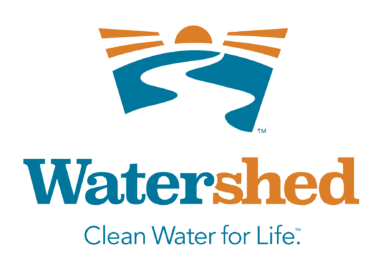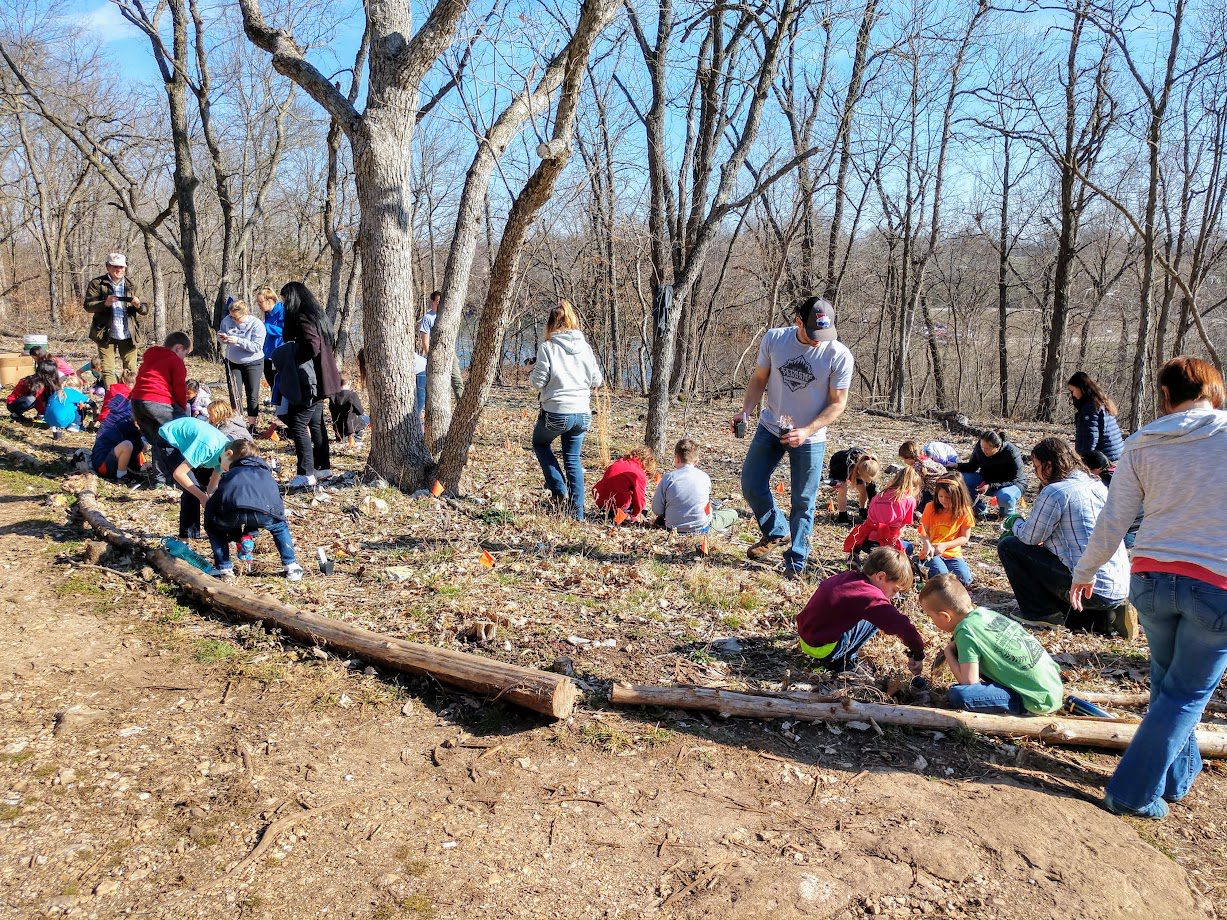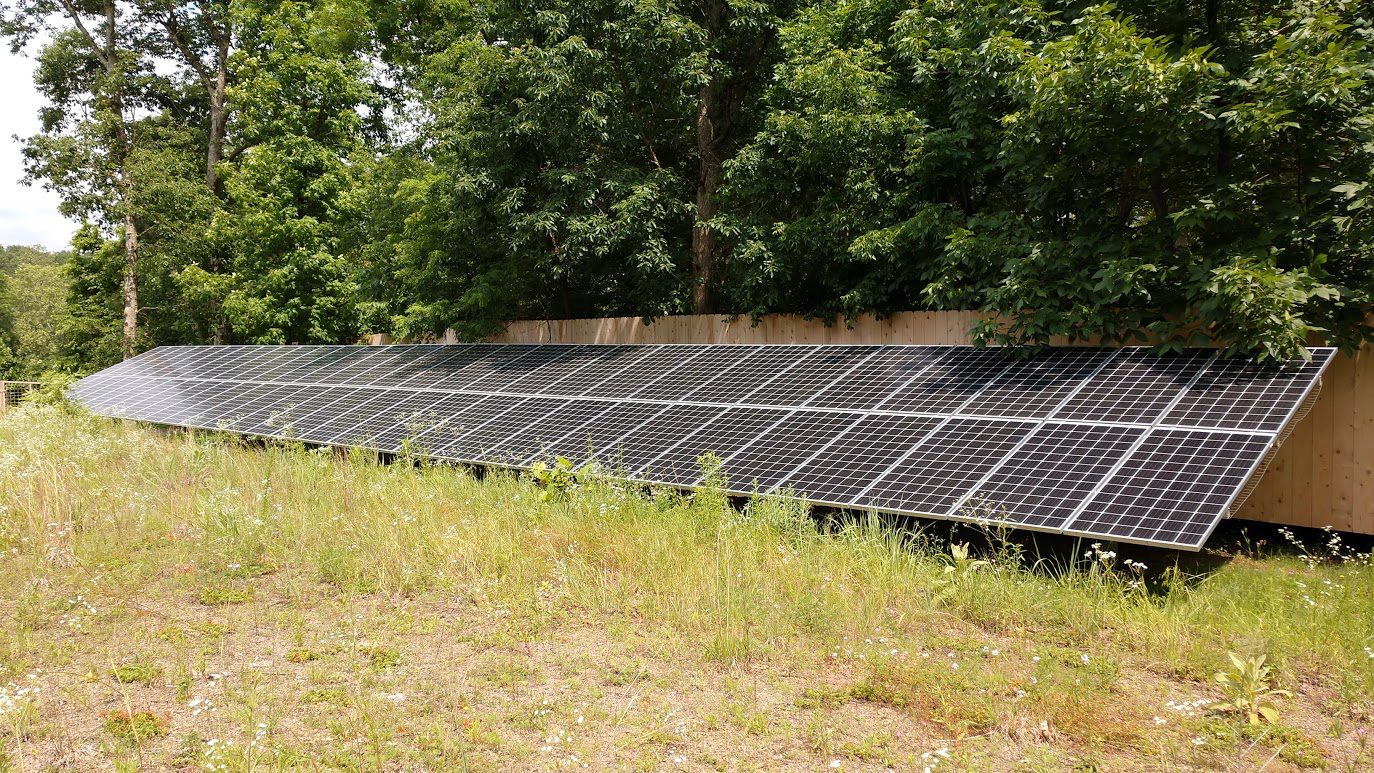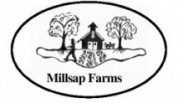Completed Projects
Missouri Bird Habitat Conservation Initiative
USDA Conservation Technical Assistance Grant
The Watershed Committee of the Ozarks was awarded the USDA Conservation Technical Assistance Grant for $49,0000 on September 15, 2018. The project is titled the Sac and James River Watershed Conservation Outreach Project and the objective of the project is to promote public awareness and implementation of Farm Bill activities, especially in historically underserved communities and in watersheds critical to drinking water supply. The project partners include the Greene, Polk, Cedar and Dade County NRCS and Soil and Water Conservation Districts, and the Missouri Department of Conservation and the grant will end September 15, 2020.
As part of the grant WCO has created a survey to understand what knowledge farmers, producers and growers have of the farm bill practices and cost share programs currently available. A local contact list for the watershed is being generated to disperse the survey. As part of the grant milestones, outreach conservation workshops will be conducted focusing on soil health and managed grazing.
MDC Community Conservation Grant
Darr Family Foundation Grant
The Watershed Committee received a $10,000 grant from the Darr Family Foundation (DFF). This funding will be used to help establish a nursery operation, focused on native plants, at Hillcrest High School.
In partnership with Springfield Public Schools (SPS), the Watershed Committee has helped develop a 3-year “college and career pathway” program at Hillcrest. SPS describes this pathway this way: “The Environmental and Natural Resource Management Pathway teaches students how to properly manage land, water, soil, plants, and animals. These classes have a focus on how management affects the quality of life for both present and future generations.” More recently, school leaders have embraced the inclusion of agriculture within this pathway, and are excited to establish the first Future Farmers of America student organization in the SPS system at Hillcrest. The program will provide industry recognized credential opportunities, and readiness for a variety of college and/or career pathways such as agriculture, environmental restoration, the sciences, and more.
The native plant nursery component of this program is integral. The opportunity for the students to be involved with growing and selling native plants blends science, business, and agriculture. Coupled with the growing demand for native plants in the market, the Watershed Committee intends to market and sell the plants produced to generate enough revenue to support the program. Seed money from the DFF will help us create a truly sustainable program and incredible opportunity for local students.
DNR Section 319 Nonpoint Source
Implementation Grant (BIG URBIE)
Project Completed June 2015
The Big Urbie Final Reports
- Big Urbie Final Report: HERE
- OEWRI South and Fassnight Creek Water Quality Assessment Final Report: HERE
- OEWRI Detention Basins Final Report: HERE
Expanded
In April 2013, WCO was awarded an additional $100,000 grant funds which will be matched with $66,667 in matching funds. The award will allow more stormwater improvement projects to be completed.
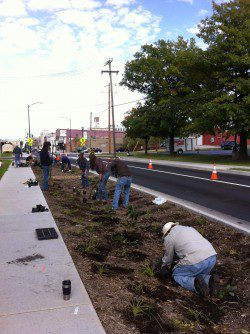 The Section 319 grant implements stormwater improvement practices that reduce and treat runoff from streets, buildings and parking lots, thereby protecting area streams, lakes and springs. The improvements are being implemented at residences, businesses, schools, and community parks located in the South Creek, Fassnight Creek, Jordan Creek and Pea Ridge Creek watersheds. The grant also monitors the water quality before and after improvements are installed. This allows local experts to measure the effectiveness of these natural solutions for reducing, absorbing and treating stormwater runoff.
The Section 319 grant implements stormwater improvement practices that reduce and treat runoff from streets, buildings and parking lots, thereby protecting area streams, lakes and springs. The improvements are being implemented at residences, businesses, schools, and community parks located in the South Creek, Fassnight Creek, Jordan Creek and Pea Ridge Creek watersheds. The grant also monitors the water quality before and after improvements are installed. This allows local experts to measure the effectiveness of these natural solutions for reducing, absorbing and treating stormwater runoff.
Projects Implemented
During the 2014 calendar year, several stormwater water quality projects were completed including rain gardens, tree box filters, bioswales, riparian corridor improvements and designs for LID (low impact development) stormwater best management practices.
- 4 Big Urbie Clean-ups with a total of 134 volunteers
- 5 volunteer planting days with a total of 98 volunteers
- Partnered with Springfield Public Schools to construct pervious pavement parking lots at Boyd Elementary and Robberson Elementary consisting of a gravel infiltration swales, native vegetation and rain barrels
- Constructed new detention basin stormwater improvements at Missouri State University and Drury University to promote infiltration
- Partnered with MSU Campus Construction Team, Facilities Management, and Students for Sustainability Commission to construct a 20,000 gallon rainwater collection system at the William H. Darr School of Agriculture. This innovative project utilizes rainwater collected from the roof for dust suppression inside the Pinegar Arena
- Funding from Big Urbie allowed the City Streets Department to construct their first pervious pavement parking lot
- Partnered with Missouri Department of Conservation to install a pervious paver patio at Homegrown Grocery
- Partnered with Gilardi’s Restaurant to collect 1,700 gallons of rainwater from their roof to help water their vegetable and herb gardens
- Constructed a rain garden with native plants for Messiah Lutheran Church
- Project WET (Water Education for Teachers) held a two-day course Stormwater Management for Educators course at Missouri State University June
- Two parking lots at the City Government Plaza will be retrofitted with pervious pavement, rain gardens, and a bioswale that will allow rainwater to soak into the ground and be used and naturally filtered by soil, plants, and trees
- Held 4 Big Urbie Steering Committee Meetings
History
The Watershed Committee of the Ozarks has been awarded a Section 319 Nonpoint Source Implementation Grant by the Missouri Department of Natural Resources. The grant total award will be $1,000,000 applied over four years (2012-2015) toward stormwater best management practices to reduce nonpoint source pollutants in Springfield and Greene County. A variety of water quality improvement projects including rain gardens, rainwater harvesting, native vegetation, vegetative filters, infiltration trenches, streetscapes projects, riparian restoration projects and retrofits of standard detention basins will be implemented in four targeted sub-watersheds; Jordan Creek, Fassnight Creek, South Creek and Pea Ridge Creek. The project name is the Springfield/Greene County Urban Watershed Stewardship Project, which has been dubbed the Big Urbie.
Project partners include Watershed Committee of the Ozarks, city of Springfield Storm Water Services Division, Greene County Resource Management, Ozarks Environmental and Water Resources Institute, Missouri State Project WET, James River Basin Partnership and Ozark Greenways.
Since the DNR Section 319 Grant has multiple partners, a grant webpage called Big Urbie, was created and is maintained by the city of Springfield. Please visit the Big Urbie website to find project details, milestones, pictures, updates and current news.

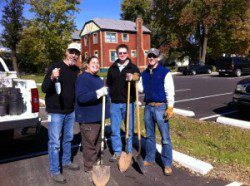
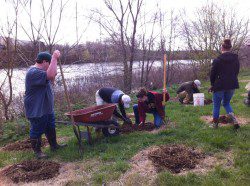
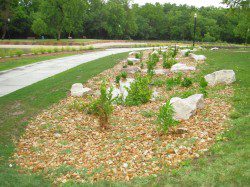
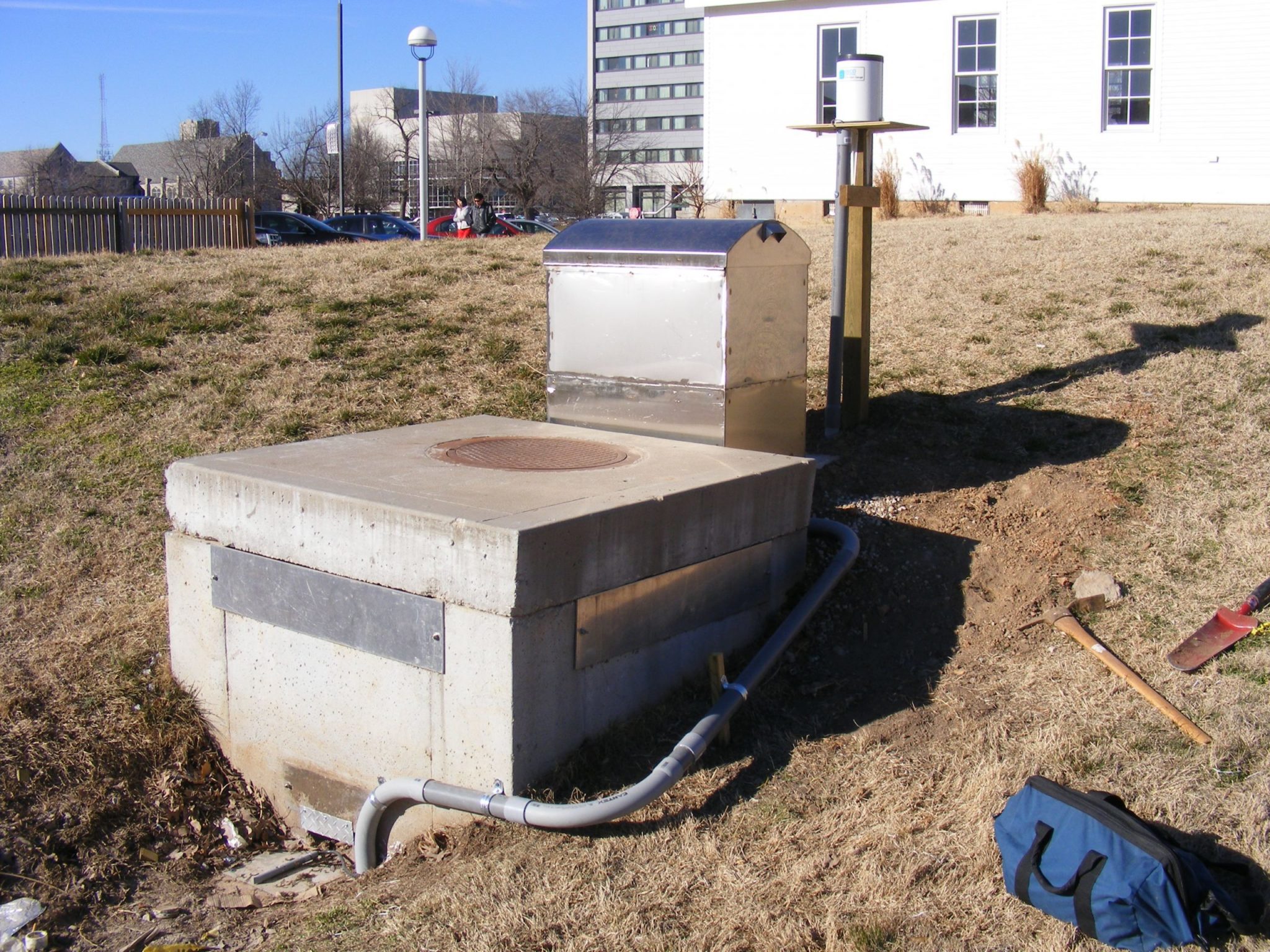
Jeep Extreme Terrain Clean Trail Grant
Our thanks to the many organizations who helped make the The Summit Preparatory School of Southwest Missouri All Service Day at the Watershed Center a huge success! Almost 200 students and parents found time to help with a variety of projects throughout the park. Students ranging from pre-school to seniors worked to improve trail access, eliminate invasive species, and restore native habitats. This was the second year for the Watershed to host this program and we are looking forward to many more.
Lower elementary grades focused on habitat restoration. Kindergarten through 3rd grade students planted almost 60 native plants in the glade restoration area. These plants will join the 50 plants students planted the previous year. Preschool students started native grass seed plugs by planting Big and Little Bluestem seeds. Once they germinate, these will then be planted in our savanna and prairie restoration areas.
Upper elementary students in 4th and 5th grade did a fantastic job starting the trailhead restoration project. The area connecting the Watershed Center needed a great deal of work. The students lined the new section of trail with stone edging and covered the upper section of the trail with mulch to create a much nicer walkway for guests. Middle school and high school students worked on many different projects while they were here. Some students helped remove an invasive species of plant known as wintercreeper. Once established, wintercreeper is extremely difficult to get rid of. Large areas of wintercreeper were cleared from the bottomland forest habitat thanks to the students’ efforts.
Some students put final touches to the trailhead work started earlier in the day. Additional loads of mulch were placed on the trail and edging stones were placed in their final positions. A third group of students learned the old-fashioned way to create split rail fencing. Using hammers and wedges, these students created split rails out of cedar logs that had been cut down in the glade restoration area. These rails are then used to line the trail encouraging visitors to stay on the trail and protecting the recently restored native plants.
Throughout the day Missouri State University’s Wildlife Society members were there to assist the students with their tasks. Funding to purchase tools for students to use was made available by the Jeep ExtremeTerrain’s Clean Trail Grant program. Native plants were purchased by a grant through the Missouri Bird Conservation Initiative
Lucky’s Markey Community Impact Grant
Project Summary
The Watershed Committee received a Community Impact Grant from Lucky’s Market to provide funding to help restore the Little Sac Agricultural Demonstration Area (ADA). This area is located between Fellows and McDaniel lakes. The land is owned by City Utilities, which has leased the parcel to WCO to manage this endeavor. The ADA will showcase riparian protection, prescribed/rotational grazing, warm and cool season pastures, and alternative watering systems. The ADA will be used for classes, tours, and scientific study, and offer sub-leases to local farmers who want to use the land within the restorative farming principals. The Natural Resources Conservation Service and the Greene County Soil and Water District will be the primary education partners, and Missouri State and City Utilities will likely participate in the science and research aspects.
Some of the infrastructure from the original project will be re-used, and some of the previous improvements—like a warm-season grass pasture and a robust buffer of trees along the stream—will be valuable assets. Funds from the Little Sac Restoration and Improvement Project, City Utilities, and this grant from Lucky’s Market will help bring the Little Sac Agricultural Demonstration Area back into working order. We hope to reopen the ADA by the end of the year. A lot of groundwork has been laid in 2017, and we are looking forward to developments in 2018
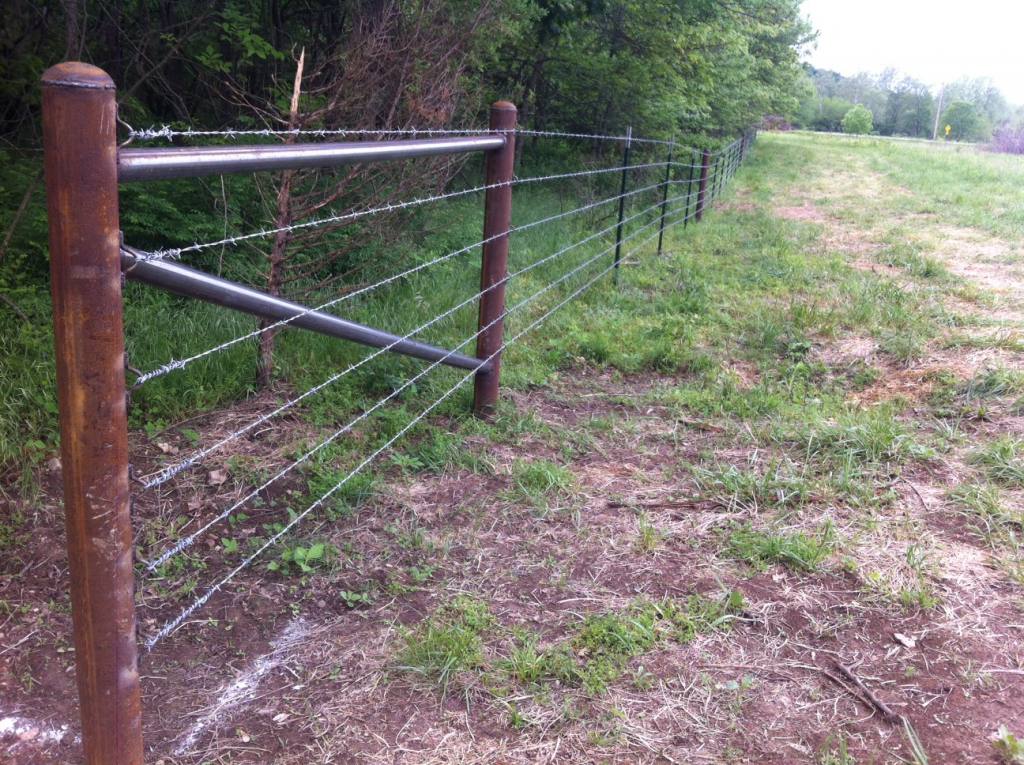
Ozark Headwaters Recycling and Materials Management District Grant
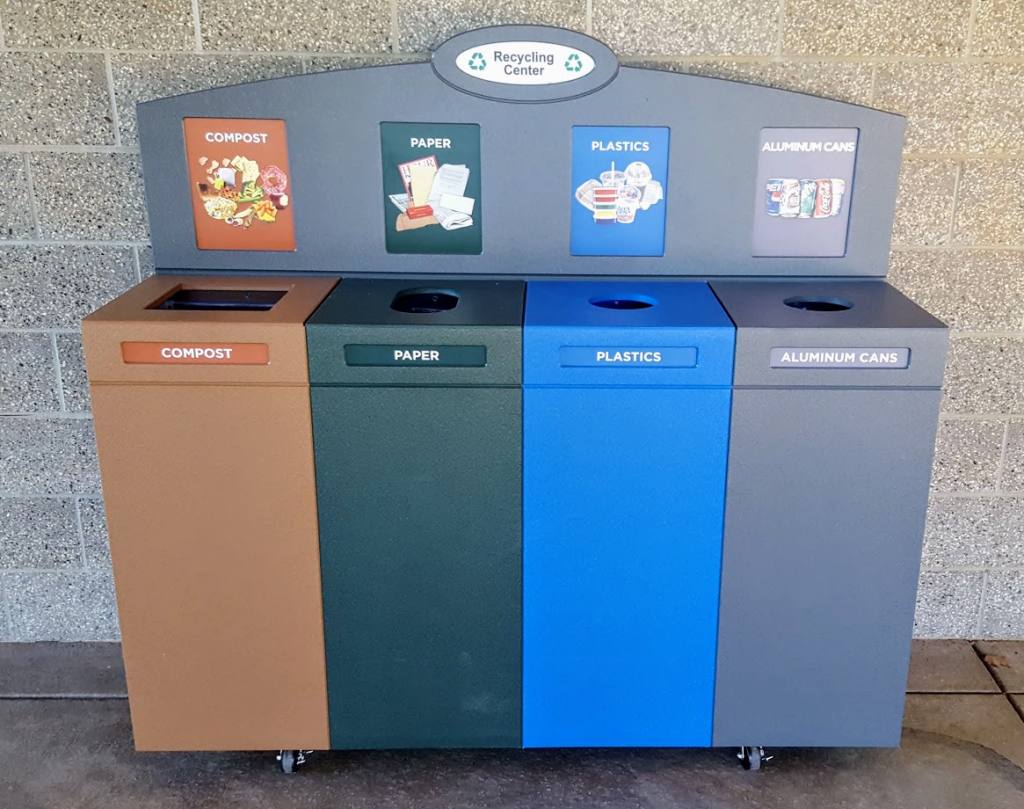
Project Summary
In April of 2018 we were awarded a $21,156.00 grant through the Ozarks Headwaters Recycling and Materials Management District. The grant funds are designed to reduce the amount of solid waste generated and sent to the landfill. Through this grant we were able to install recycling bins throughout the park and purchase a utility vehicle and trailer for maintaining the bins.
We also created an educational program focusing on the connection between solid waste disposal and water quality. A key component of this program is to work with school groups visiting the park to educate both students and parents about reducing solid waste. Students eating lunch at the Watershed Center participate in a Litter Less Lunch activity where students sort their lunch waste into recyclable, compostable, and disposable streams. Not only does this activity reduce the steam of waste generated by the students, it also provides a hands-on experience on the importance of producing less waste. We hope that our Litter Less Lunch message spreads to both the parents and schools and they find ways to reduce the impact of school lunches on waste streams flowing to landfills.
HDR Grant
Project Summary
In late 2018, we finally realized a long-term goal of adding renewable energy generation to the Watershed Committee of the Ozarks! The HDR Foundation made it possible. But what is the HDR Foundation?
The HDR Foundation is affiliated with HDR Inc., a premier engineering firm with global reach, although the two are legally separate entities. HDR Inc. The one-time gift from HDR will literally be the gift that keeps on giving—every time the sun shines on the solar array. The solar array will reduce operating costs, essentially allowing us to spend less money on energy and therefore allow us to apply more resources to our mission. In very real terms, the cost-savings will allow us to hire an additional part-time educator for the busy spring and fall field trip seasons.
The solar array also provides another educational opportunity for the Watershed Center. The solar array comes with monitoring equipment that populates a real-time dashboard which can be accessed online through a computer or mobile device. The dashboard elegantly shows current energy output, kilowatt hours per day, and keeps a running tally of carbon offset and cost savings. We plan to continue developing the educational component with our partners at City Utilities and Sunbelt Solar encourages employees to be engaged in their local communities and leave their mark on the future through partnerships aligned with HDR’s values and areas of expertise. The HDR foundation was founded on July 12, 2012 to extend that corporate ethic, and the Foundation is fueled/funded primarily by donations from employees of HDR Inc. Watershed Committee of the Ozarks board member and former board chairman Eric Dove works for HDR Inc. which provided access for WCO to apply to the HDR foundation for grant funding. The HDR Foundation has provided more than $1 million in grant funding to deserving nonprofit organizations from all across the United States, and WCO was the beneficiary of a major grant of $80,000, which was the largest single disbursement the HDR Foundation had awarded to date!
Solar was an instrumental partner in the project. From the onset, Sunbelt stepped up in a big way by agreeing to provide $10,000 in in-kind services for the installation of the project which helped both in the grant application process and with the success of the project over all. The project had many, many twists and turns, including new steel and solar tariffs which affected prices and design possibilities, buried lines, City codes, and aesthetic considerations. The Sunbelt team was with us from start to finish and adapted to all the challenges that we encountered. Upon the writing of this, our solar array seems to be performing like a “hot rod” in comparison to other local systems.
Partners
HDR, Sunbelt Solar
C.W. Titus Grant
Project Summary
Late in 2018, the C.W. Titus foundation came through with a grant which should allow the Watershed Center to become net-positive, or to generate more energy than we consume. The way we hope to get there is two-fold. The grant will allow us to do a major energy efficiency upgrade to the outdoor restrooms attached to the C.W. Titus Education Facility. The restrooms use a prodigious amount of energy because of the uninsulated structure with electric resistance heating (think giant space heaters in a two story continually vented chimney). In 2019, in partnership with Springfield Greene County Parks, we will add insulation, lower the ceilings, and add a highly efficient heat source called a mini-split heat pump system. The area above the new ceilings will also add an attic storage space which will be useful as we grow. The remainder of $45,000 grant will allow us to add roof-mounted solar panels to the Lakeside Pavilion, which is an excellent location for solar based on the access to direct sun and a separate meter which can be utilized. The generosity of the HDR employees through the HDR foundation, the C.W. Titus Foundation, Sunbelt Environmental, and the Springfield Greene County Park Board have lead to some incredible developments, and we are excited to report on the outcomes in our 2019 annual report.
Dear Future Community Challenge Grant by Coca-Cola Company
Project Summary
The Coca-Cola Company and its family of 68 independently owned bottlers across the country invited young Americans to help deliver a better tomorrow through the “Dear Future [Community] Challenge.” Locally, Ozarks Coca Cola Dr. Pepper Bottling Company and Watershed Committee of the Ozarks teamed up to ask students and young adults at Drury, MSU, and OTC their ideas “to protect and restore Ozarks water resources.” After reviewing many submissions, an award of $30,000 went to Ashley Cusic for her idea to protect and restore waters by preventing erosion and planting native plants. WCO served as a mentor and fiscal agent to help Ashely actualize her idea.
WCO surveyed local partners for “needs” or projects that might align with Ashley’s idea. Ashley decided the best fit was a project need of Ozark Greenways. A section of the Frisco Highline trail, located within Springfield’s water supply area, was eroding badly. With the investment from Coke and Ashley, Ozark Greenways was able to fund the work to stabilize the stream bank with stone and native plants. This unique project provided the opportunity to engage many students, build a relationship with Ozarks Coca Cola Dr. Pepper Bottling Company, and our student partner Ashley, as well as fix a problem and make he water cleaner.
Partners
Ozarks Coca-Cola/Dr. Pepper Bottling Co., Ozark Greenways, Wildscape Environmental
Mo Bird Conservation Initiative Grant
Project Summary
Purpose of Grant: The purpose of this project is to restore the native habitats at the Watershed Center at Valley Water Mill Park through the implementation of the Forest Stewardship Management Plan provided by the Missouri Department of Conservation (MDC). These actions align with our mission, “to sustain and improve the water resources of Springfield and Greene County through education and effective management of the region’s watersheds.” and the Missouri Bird Conservation Initiative (MoBCI) goals to “get people excited about birds” and pursue “integrated, all-bird conservation” (adapted from MoBCI website). The habitat improvements we propose to make will benefit birds, native flora and fauna, improve water quality, and improve the overall resilience of the Watershed Center and Valley Water Mill Park to natural or human generated stressors, and therefore, accomplish the goals of MoBCI and the Watershed Committee of the Ozarks (WCO). Why use MoBCI Resources at the Watershed Center and Valley Water Mill Park?
- The Watershed Center is a birding hot-spot because of the habitat diversity, access to water, and proximity to City—it’s important for the birds, and for teaching people about conservation.
- Ebird data shows 189 bird species have been reported at Valley Water Mill Park which illustrates the importance of this location to migrating and nesting birds, and to the dedicated people who watch and study them at the Watershed Center.
- Of the 189 bird species recorded here, three species, the Northern Harrier, Snowy Egret, and Peregrine Falcon are designated Endangered in the State (Missouri Species and Communities of Conservation Concern Checklist, Missouri Department of Conservation, 2016).
- The location will be on the Great Missouri Birding Trail in 2017.
- The Greater Ozarks Audubon Society (GOAS) has a long-term commitment and involvement to the site, with projects including feeder stations, a waterfowl observation blind, a watering bubbler and chimney swift towers. GOAS frequently leads field trips to the site.
- In 2015, over 3,500 students visited the Watershed Center and participated in educational programs; the surrounding Valley Water Mill Park is visited by thousands of people each year.
- Our wetland and small reservoir are spring-fed and stay ice free most winters, making it an important resting place for migratory waterfowl during extended cold periods.
- We work to explain these and other methods of implementing good land stewardship to program participants, visitors, and volunteers, hopefully multiplying the impact.
- Habitat improvements to our grassland parcels will provide benefits for birds and native pollinators such as monarchs, and increase ecosystem diversity.
- We work closely with MDC, Missouri Master Naturalists, Greater Ozarks Audubon Society, Springfield Greene County Park Board, the City of Springfield, and Greene County which provides excellent partnerships for education and data gathering, such as “bio-blitz” activities.
- This project will involve a massive amount of volunteer participation and labor providing significant in-kind resources.
Little Sac Restoration and Improvement Grant
Project Summary
Watershed Committee of the Ozarks was awarded a subgrant agreement from the Missouri Department of Natural Resources to improve the drinking watershed of Springfield and Greene County. The project will focus on reducing the loading of pollutants identified in the 303(d) watershed(s) and accompanying Total Maximum Daily Load (TMDL) for the Upper Little Sac River, as described and recommended in the watershed based plan for that basin, by targeting the sub-watershed for the implementation of BMPs that will reduce nonpoint source pollution. The approach of this project will be to monitor the performance of the selected best management practices (BMPs). Practices will include a demonstration of Longitudinal Peaked Stone Toe Protection (a method of stabilizing eroding banks), prescribed grazing systems, bank vegetative buffers, and alternative livestock watering sources at individual sites and regional levels in the sub-watershed, as well as estimate sub-watershed pollutant loading improvements at sub-watershed outlets. The BMP designs and improvements will then be incorporated into criteria manuals for future policies and ordinances addressing agricultural and urban water quality. Project partners, namely City Utilities of Springfield, the Greene County Soil and Water Conservation District, and the Missouri Department of Conservation will assist in BMP implementation and monitoring of the projects implemented.
On June 21, 2018 the Missouri Department of Natural Resources awarded an additional grant amendment bringing the total grant funding to $380,442 with a required $225,222 in local match. The final year of the grant will be focused on writing and updating our EPA nine element Upper Little Sac Watershed Management Plan. The grant will be extended until May 31, 2019.
As part of the Little Sac Restoration and Improvement Project on November 6-8, 2017 the Watershed Committee of the Ozarks hosted a hands-on educational workshop, which coincided with the construction of a stream stabilization project on the Little Sac River. Forty people participated in the workshop to help construct the Longitudinal Peaked Stone Toe Protection streambank stabilization project, which includes an engineered floodplain bench, bendway weirs, unrooted live pole plantings, vegetated and curved keys, and rooted stock plants. Mr. Dave Derrick a Potomologist and Stream Stabilization Specialist with River Research & Design, Inc. from Vicksburg, MS with over 20 years’ experience lead the workshop and provided construction oversight.
This project helps reduce nonpoint source pollutants from entering the Little Sac River, which will benefit our drinking water supply for many years to come. We are very thankful to all of our community partners that made this project possible including the landowners, the grant steering committee, Missouri Department of Natural Resources, Greene County, Missouri Department of Conservation, Wildscape Environmental Services and all of our workshop attendees!
The final year of the grant will be focused on writing and updating our EPA nine element Upper Little Sac Watershed Management Plan. Part of the plan updates include the Bacteria Source Tracking Report for the Little Sac River, which was recently completed by Missouri State University Ozarks Environmental and Water Resources Institute. Bacteria samples were collected at five sites in the watershed in fall 2017 to look for presence of human, bovine, chicken, goose and dog bacteria markers. The results can be found below:
- Soil and Water Assessment Tool (SWAT) simulated flow and bacteria in Little Sac Watershed: A Best Management Practice Assessment
- Bacteria Source Tracking to Support Watershed Planning, Little Sac River, Southwest Missouri
- Final Report
Partners

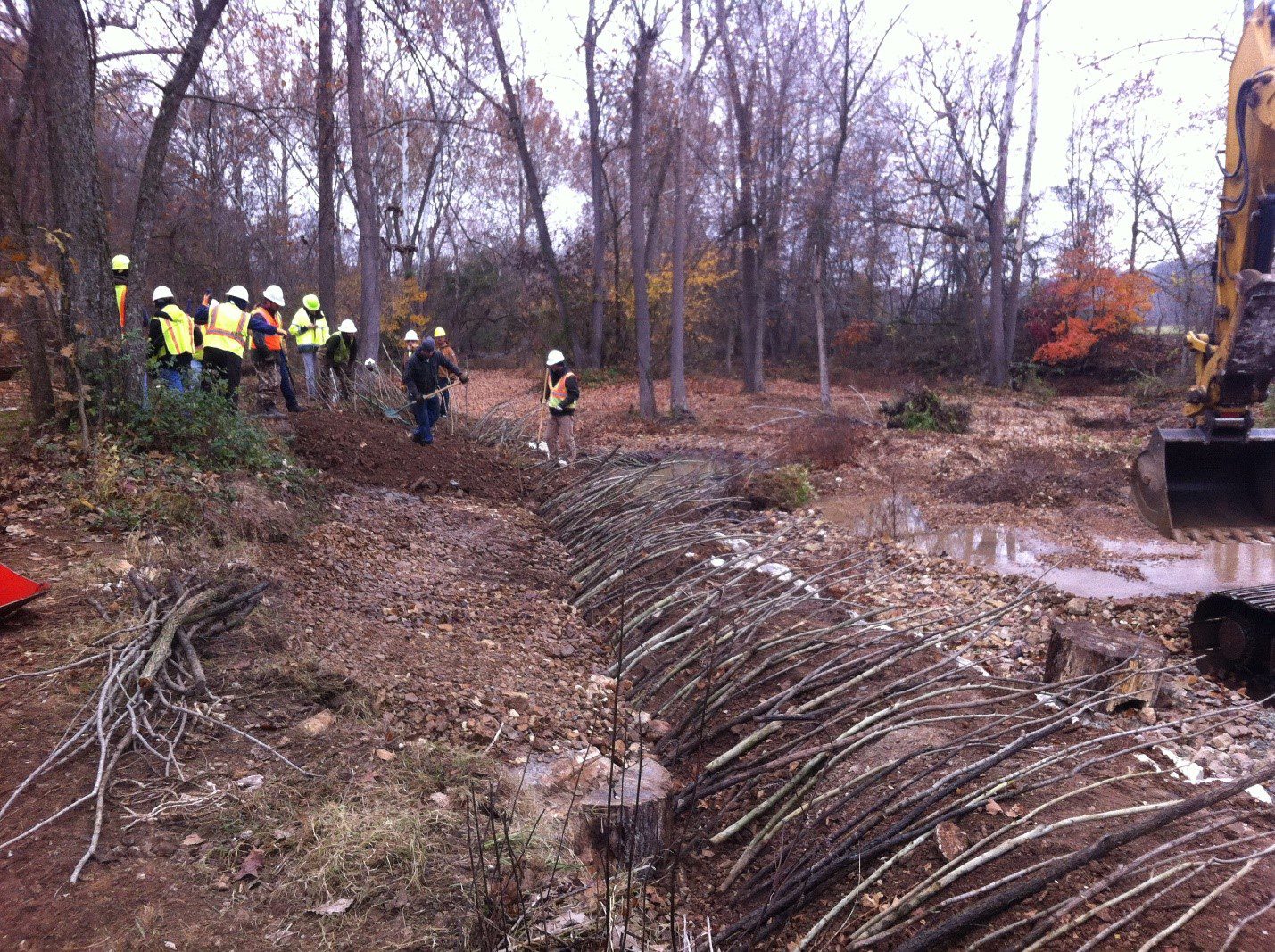
Solid Waste District O Grant
Project Summary: Completed July 2011
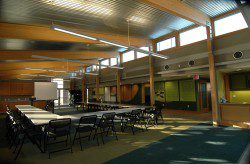 The Watershed Committee of the Ozarks was awarded a Solid Waste District O grant in the amount of $50,000 to demonstrate the use of recycled products in the meeting room at the C.W. Titus Education Facility at the Watershed Center. This will include recycled aluminum windows, recycled plastic in carpeting, low VOC paints and adhesives, cabinetry made of reused wood and energy efficient lighting.
The Watershed Committee of the Ozarks was awarded a Solid Waste District O grant in the amount of $50,000 to demonstrate the use of recycled products in the meeting room at the C.W. Titus Education Facility at the Watershed Center. This will include recycled aluminum windows, recycled plastic in carpeting, low VOC paints and adhesives, cabinetry made of reused wood and energy efficient lighting.
C.W. Titus Educational Facility
Project Summary: Completed July 2011
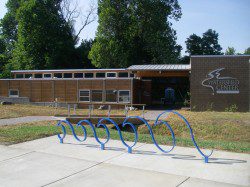 The C.W. Titus Education Facility–the crowning project of the Watershed Center–was completed in the Fall of 2011. The Facility is a low impact, environmentally conscious building that models “green” engineering and architectural technologies. Building materials and methods used both conserve and efficiently use natural resources, and promote a a healthy, productive environment for employees, students, and visitors alike. The facility is used for educational programs, and can be rented for private events. It comes equipped with tables and chairs for 75, a kitchenette, projector, WiFi, and more. The C. W. Titus Education Facility hours are seasonal and can be adjusted by appointment.
The C.W. Titus Education Facility–the crowning project of the Watershed Center–was completed in the Fall of 2011. The Facility is a low impact, environmentally conscious building that models “green” engineering and architectural technologies. Building materials and methods used both conserve and efficiently use natural resources, and promote a a healthy, productive environment for employees, students, and visitors alike. The facility is used for educational programs, and can be rented for private events. It comes equipped with tables and chairs for 75, a kitchenette, projector, WiFi, and more. The C. W. Titus Education Facility hours are seasonal and can be adjusted by appointment.
Southwest Missouri Water Quality Improvement Project (WQIP)
Project Summary:
Springfield-Branson Onsite Remediation Project.
The Watershed Committee of the Ozarks was awarded funds through the Southwest Missouri Water Quality Improvement Project (WQIP**). The goal of this project is to improve and protect water quality while enhancing economic development for municipalities, agriculture, and tourism. This is a multi-faceted project involving several organizations, each focusing on a different water quality issue. Under this umbrella, the Watershed Committee of the Ozarks (WCO) is currently working with the Table Rock Water Quality Incorporated (TRLWQ) to demonstrate the remediation of onsite wastewater treatment systems that have failed and pose a threat to contaminating ground water. Many conventional septic systems installed in the past have been shown through scientific studies to be inadequate for many locations throughout Southwest Missouri and can negatively impact the quality of groundwater, and ultimately drinking water.
The completed projects include the remediation of sixteen onsite wastewater systems that were failing to groundwater, seven educational onsite wastewater trainings, installation of public, low-flow outdoor restrooms and partial funding for the parking bays, loop drive, permeable walkway pavers and fire truck access for the C.W. Titus Education Facility at the Watershed Center.
DNR Recreational Trails Grant
Project Summary: Completed July 2012
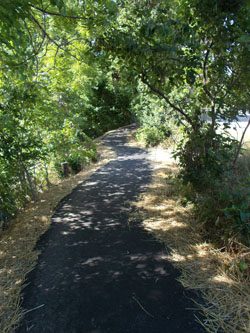 In March of 2011, the Watershed Committee received a Recreational Trails Grant from the Missouri Department of Natural Resources. The purpose of this grant is to construct 1,550 ft. of hard surface trail connecting the existing Lakeside Learning Station to the newly constructed C.W. Titus Education Facility. The grant will also provide money to aide in construction of a trailhead and parking lot of the building. Total project costs are estimated at $143,090, with $85,000 of the amount coming from the federal grant and the remaining coming from local matching funds. When completed, the trail section will increase the hard surface trails on the site to just over 3,000 ft.
In March of 2011, the Watershed Committee received a Recreational Trails Grant from the Missouri Department of Natural Resources. The purpose of this grant is to construct 1,550 ft. of hard surface trail connecting the existing Lakeside Learning Station to the newly constructed C.W. Titus Education Facility. The grant will also provide money to aide in construction of a trailhead and parking lot of the building. Total project costs are estimated at $143,090, with $85,000 of the amount coming from the federal grant and the remaining coming from local matching funds. When completed, the trail section will increase the hard surface trails on the site to just over 3,000 ft.
Community Response Challenge Grant Program
Community Response Challenge Grant Program. The Watershed Committee of the Ozarks was awarded $6,000 in matching funds as a recipient of the Community Response Challenge Grant Program from the Community Foundation of the Ozarks. The Watershed Committee will use the funds to promote high-efficiency toilets to reduce residential water use through our partnership with City Utilities of Springfield Water Wise program.
Resources


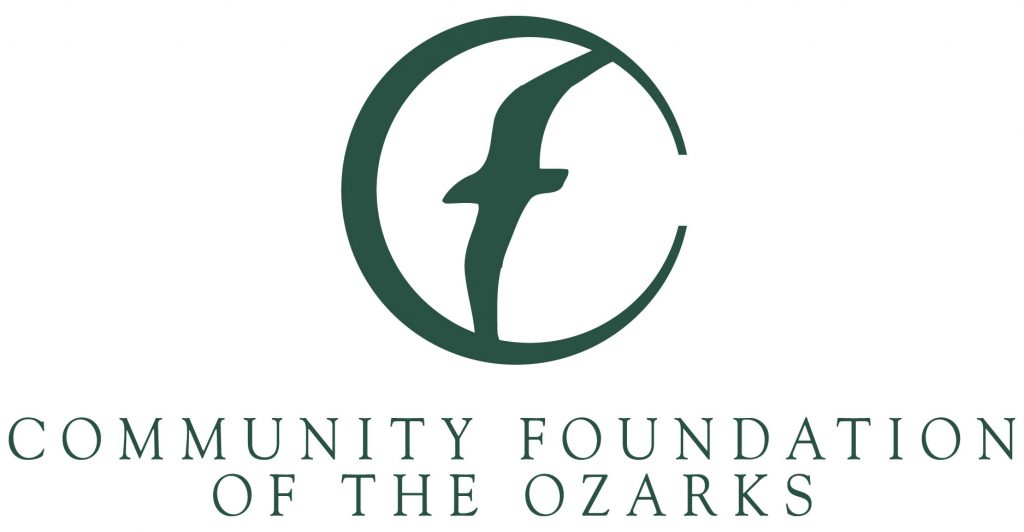
Asher Creek Project
Project Completed October 2013
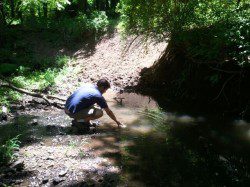 The Watershed Committee of the Ozarks (WCO) partnered with the Greene County Soil and Water Conservation District (GCSWD) to conduct the water quality sampling component for the Asher Creek 319 Project. WCO and the GCSWD have the common objective of encouraging the responsible use of our natural resources and the protection of critical drinking water supplies in the Little Sac River Watershed. WCO collected the water quality grab-samples, flow measurements, downloaded stage logger data, and delivered the samples to Ozarks Environmental Water Resources Institute for analysis.
The Watershed Committee of the Ozarks (WCO) partnered with the Greene County Soil and Water Conservation District (GCSWD) to conduct the water quality sampling component for the Asher Creek 319 Project. WCO and the GCSWD have the common objective of encouraging the responsible use of our natural resources and the protection of critical drinking water supplies in the Little Sac River Watershed. WCO collected the water quality grab-samples, flow measurements, downloaded stage logger data, and delivered the samples to Ozarks Environmental Water Resources Institute for analysis.
The Asher Creek watershed is a sub-basin of the Little Sac Watershed in Greene and Polk Counties. The Little Sac River Watershed includes Fellows Lake, McDaniel Lake, and Stockton Lake and makes up the majority of the City of Springfield’s public drinking water supply. The primary goal of the Asher Creek water quality weekly monitoring effort was to identify the bacteria levels and quantify the nutrient loads within the watershed.
The 18 month water quality monitoring was conducted from May 1st, 2012 to October 31st, 2013 with a total of 343 samples being collectedThe Watershed Committee of the Ozarks (WCO) partnered with the Greene County Soil and Water Conservation District (GCSWD) to conduct the water quality sampling component for the Asher Creek 319 Project. WCO and the GCSWD have the common objective of encouraging the responsible use of our natural resources and the protection of critical drinking water supplies in the Little Sac River Watershed.
WCO collected the water quality grab-samples, flow measurements, downloaded stage logger data, and delivered the samples to Ozarks Environmental Water Resources Institute for analysis.
The Asher Creek watershed is a sub-basin of the Little Sac Watershed in Greene and Polk Counties. The Little Sac River Watershed includes Fellows Lake, McDaniel Lake, and Stockton Lake and makes up the majority of the City of Springfield’s public drinking water supply.
The primary goal of the Asher Creek water quality weekly monitoring effort was to identify the bacteria levels and quantify the nutrient loads within the watershed. The 18 month water quality monitoring was conducted from May 1st, 2012 to October 31st, 2013 with a total of 343 samples being collected. The results yielded E.Coli bacteria levels exceeding the State of Missouri water quality standard for whole-body contact at all sites. Seasonal trends in concentrations show that sources of bacteria are varied throughout the year at different locations in the watershed and should be investigated further.
USDA Conservation Innovation Grant
Project Completed October 2013
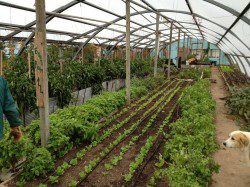 The Conservation Innovation Grant concluded on October 31, 2013. The $100,000 project (50% match) accomplished a variety of projects to safeguard our local water resources. The Watershed Committee of the Ozarks administered the grant, and also produced a rainwater harvesting manual for Southwest Missouri, and a dynamic web-based resource called “How to Farm in the City” as part of the project. Urban Roots Farm and Millsap Farm were the two producers involved in the Conservation Innovation Grant.
The Conservation Innovation Grant concluded on October 31, 2013. The $100,000 project (50% match) accomplished a variety of projects to safeguard our local water resources. The Watershed Committee of the Ozarks administered the grant, and also produced a rainwater harvesting manual for Southwest Missouri, and a dynamic web-based resource called “How to Farm in the City” as part of the project. Urban Roots Farm and Millsap Farm were the two producers involved in the Conservation Innovation Grant.
Urban Roots Grant Project Included:
Installation of high tunnels (match)
Constructing a 600 sq. ft. packaging and washing house for washing and storing produce prior to distribution. The project utilized innovative building design, rain water harvesting, highly efficient insulation, passive heating/cooling, and re-claimed construction materials and equipment. Installing a rain garden to catch parking lot runoff and water from the pack/wash shed (a.k.a., draingarden).
Millsap farms grant projects included:
- Testing bio-strip Intercropping
- Constructing a Chinese high tunnel (a innovative, bermed in greenhouse that is proving to be warmer with less energy/cost inputs that conventional designs)
- Planting an organically-controlled disease resistant orchard
Implementing water and energy demonstration practices - Starting a vermicomposting unit
- Installing raised bed gardens/impervious parking removal
Additionally, this project provided a good connection to the burgeoning local food movement. As local agricultural production grows to meet the goal of 20% local by 2020, demonstrations of water wise micro-farming practices are important.
Education opportunities for the public will come in the form of workshops, field days and two publications:
1) How to Farm in the City
2) Rain Water Harvesting Manual for Southwest Missouri. PDF HERE
Resources
Our Missouri Waters
The goal of Our Missouri Waters is to create a Healthy Watershed Plan
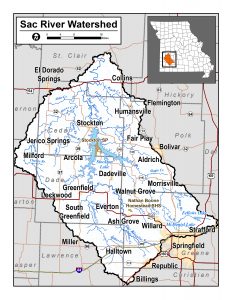 On May 1st, 2015 the Watershed Committee of the Ozarks was awarded the Our Missouri Waters Collaborative effort for the Sac River Watershed through the Missouri Department of Natural Resources. The goal of this project was to gather local input and identify water resource priorities through community meetings. A local watershed advisory committee was assembled to identify and develop resources to achieve those priorities. Citizens, community leaders, elected officials and anyone living in the watershed were invited in this process to share how they use their water and what’s needed to continue protecting and enhancing the Sac River watershed.
On May 1st, 2015 the Watershed Committee of the Ozarks was awarded the Our Missouri Waters Collaborative effort for the Sac River Watershed through the Missouri Department of Natural Resources. The goal of this project was to gather local input and identify water resource priorities through community meetings. A local watershed advisory committee was assembled to identify and develop resources to achieve those priorities. Citizens, community leaders, elected officials and anyone living in the watershed were invited in this process to share how they use their water and what’s needed to continue protecting and enhancing the Sac River watershed.
The grant was completed on October 31st 2016. The survey results, summary of the process and committee recommendations are outlined in the Sac River Healthy Watershed Plan found here. The plan will be a living, working document to help maximize resources and focus watershed priorities over the next five years. Thank you to everyone that served on the committee and helped with this project! To learn more about the Our Missouri Waters statewide initiative visit: http://dnr.mo.gov/omw/
Stacey Armstrong Smith, Projects Manager
Partners

Valley Water Mill 319 Project
Projects Completed 2002-2007
The rapid pace of urban growth in the geologically sensitive Valley Water Mill sub-watershed led the Watershed Committee to apply for Clean Water Act Section 319 funds to address urban and suburban sources of nonpoint pollution, implement water-friendly practices as demonstrations and to build and design educational facilities where citizens learn about nonpoint source pollution and develop skills to address the problems.
Springside Learning Station
The Springside Learning Station deck surface and foundation were constructed out of 100% recycled plastic material and built with volunteer labor. The platform accommodates about thirty students and is located adjacent to Sander Spring. The WCO and partners dedicated this learning station to former DNR employee Becky Shannon.
Lakeside Learning Station
The Watershed Center’s largest outdoor class room is an open-sided “green” pavilion with a beautiful view of the lake. The structure features high fly ash concrete construction, runoff absorption areas and low-maintenance steel roof supported by sustainably grown and harvested wood “glulam” beams. Landscaping around the station includes native Buffalo Grass and wildflower plantings. Dedicated to former City Utilities employee Duane Galloway.
Watershed Assesment
Missouri State University, under the direction of Dr. Robert Pavlowsky, completed an assessment of the reservoir and stream channels in the Valley Water Mill sub-watershed. This assessment work indicated that nutrient loading to the reservoir was lower than expected and sediment quality was good.
Wetland Enhancement
The wetland enhancement plan developed by Intuition and Logic Engineers included the development of several specific wetland zones with different water depths and slopes, and the planting of over 30 types of native wetland plant species. Prior the wetland was overgrown with non-native Reeds Canary Grass.
Sediment Excavation
Sediment excavation of the Valley Water Mill reservoir accomplished three goals: 1) provided downstream water quality benefits by increasing storage time and settling capacity in the reservoir, 2) maximized the 9-foot depth of the reservoir, which will discourage bottom-rooted aquatic vegetation and improve fishing, and 3) increased the storage capacity for the water supply.
MO Recreational Trails Grant
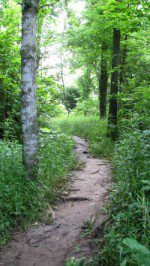 The Department of Natural Resources Trails Grant provided funds to design and complete a trail loop around the Watershed Center site. Trails maps were designed and a small section of glassphalt trail was constructed to connect the Lakeside Learning Station to the fishing piers.
The Department of Natural Resources Trails Grant provided funds to design and complete a trail loop around the Watershed Center site. Trails maps were designed and a small section of glassphalt trail was constructed to connect the Lakeside Learning Station to the fishing piers.
Wetland Curriculum Grant
Project Completed 2007
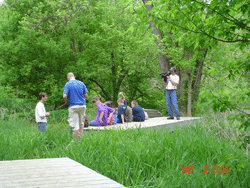 The Community Foundation of the Ozarks awarded the Watershed Committee $22,288 for the development of hands-on-education curriculum for the four outdoor classrooms at the Watershed Center. Two specific goals were to build a wetland learning station, allowing access through the wetland and designing a teacher friendly curriculum that corresponded with Missouri’s “Grade Level Expectations” or GLE’s.
The Community Foundation of the Ozarks awarded the Watershed Committee $22,288 for the development of hands-on-education curriculum for the four outdoor classrooms at the Watershed Center. Two specific goals were to build a wetland learning station, allowing access through the wetland and designing a teacher friendly curriculum that corresponded with Missouri’s “Grade Level Expectations” or GLE’s.
Streamside Learning Station
Project Completed 2007
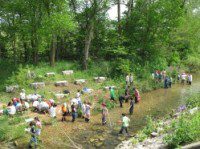 The Streamside Learning Station, on the banks of the South Dry Sac River, was completed using a grant from the Community Foundation and a donation from the Griesemer. This station consists of twelve large limestone blocks cut from the historic Phenix Quarry in Greene County. These stones, in an amphitheater arrangement along the stream bank, allow students to sit or work as they study and sample the stream. The Streamside Learning Station was dedicated to the Griesemer Family.
The Streamside Learning Station, on the banks of the South Dry Sac River, was completed using a grant from the Community Foundation and a donation from the Griesemer. This station consists of twelve large limestone blocks cut from the historic Phenix Quarry in Greene County. These stones, in an amphitheater arrangement along the stream bank, allow students to sit or work as they study and sample the stream. The Streamside Learning Station was dedicated to the Griesemer Family.
Rain Garden at Valley Water Mill Park
Project Completed Spring 2008
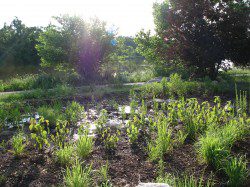 The Watershed Committee has partnered with a local Sierra Club to construct a Rain Garden at Valley Water Mill Park. This project will aid in preventing stormwater runoff from entering Valley Water Mill Lake. Rain Gardens are desinged to slow down, capture and absorb water using elements similar to those in nature: plants, rocks, shallow swales and depressions that hold water temporarily rather than let it quickly run away. Rain Gardens will reduce drainage and flooding problems, keep pollutants out of the nearby streams, rivers and lakes and bring beauty and wildlife to the landscape.
The Watershed Committee has partnered with a local Sierra Club to construct a Rain Garden at Valley Water Mill Park. This project will aid in preventing stormwater runoff from entering Valley Water Mill Lake. Rain Gardens are desinged to slow down, capture and absorb water using elements similar to those in nature: plants, rocks, shallow swales and depressions that hold water temporarily rather than let it quickly run away. Rain Gardens will reduce drainage and flooding problems, keep pollutants out of the nearby streams, rivers and lakes and bring beauty and wildlife to the landscape.
There are two kinds of rain gardens: wet and dry. The wet rain garden holds water almost all of the time. The rain garden at Valley Water Mill is a dry rain garden and most water is absorbed within 48 hours…too soon for mosquito larvae to hatch. Wildlife prefers locally grown native plants. If you plant a rain garden, be sure to buy plants native to Missouri.
Community On-Site Wastewater and Stormwater 319 Project
Projects Completed 2004-2008
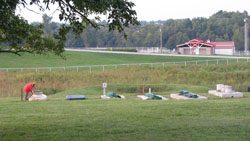 The Missouri Department of Natural Resources awarded this Section 319 Nonpoint Source Implementation Grant to the Watershed Committee. The C.O.W.S grant directed funding to address two of the biggest water quality issues related to growth: wastewater and stormwater.
The Missouri Department of Natural Resources awarded this Section 319 Nonpoint Source Implementation Grant to the Watershed Committee. The C.O.W.S grant directed funding to address two of the biggest water quality issues related to growth: wastewater and stormwater.
The Onsite Wastewater Training Center (OWTC) was one of the major milestones. The OWTC, located adjacent to the Watershed Center, serves as an outdoor classroom for wastewater installers. This facility showcases several alternative onsite septic systems, as well as innovative stormwater techniques. Failing septic systems have been shown to contaminate surface and groundwater resources, including wells used for drinking water. Community outreach projects included workshops, onsite rehabilitation and on-site coupons that will cost-share for maintenance. A cost share project provided a landowner enough incentive to work with the Watershed Committee to replace a failing system that was surface discharging directly into the Little Sac.
For a full description of the projects and accomplishments see the Final Report below
Project Partners: Greene County, Springfield-Greene County Park Board, Missouri Department of Natural Resources, Water Quality Improvement Project
Boy Scout Bridge
Completed November 2008
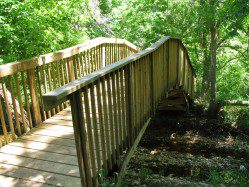 The little bridge at the Watershed Center was a big project. The stream that flows into the lake posed a major barrier to hikers and students in times of high water. With the help of Greene County, a motivated Boy Scout, and the North Side Rotary, our bridge is complete! The Jon Williams original design spans 29 feet and is about 9 feet over the stream bed in the center.
The little bridge at the Watershed Center was a big project. The stream that flows into the lake posed a major barrier to hikers and students in times of high water. With the help of Greene County, a motivated Boy Scout, and the North Side Rotary, our bridge is complete! The Jon Williams original design spans 29 feet and is about 9 feet over the stream bed in the center.
Source Water Protection Development and Implementation Grant
Project Manager: Watershed Committee of the Ozarks
Public Water System: City of Springfield, Missouri, by and for the benefit of City Utilities of Springfield, MO
Our primary goal/objective is to develop a comprehensive voluntary SWPP for the Springfield Water Supply to submit for endorsement to the Missouri Department of Natural Resources.
We will accomplish these tasks:
1) Form a local source water protection steering committee to guide the development of the voluntary community SWPP.
2) Update our potential contaminate sources listed as unconfirmed in the state data base from inventory list of the Source Water Assessment Plan.
3) Revise the “How to Protect Your Well” factsheet.-completed-under Publications
4) Create a “Source Water Protection Starts at Home” educational factsheet-completed and mailed to residents in targeted area
5) Use the plan as a Watershed Control Program suitable for Log Removal credit under LT2ESWTR if needed
Resources

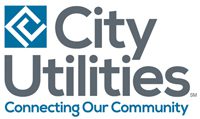
Forestry Learning Station
Completed 2008
The Forestry Learning Station is located just off the 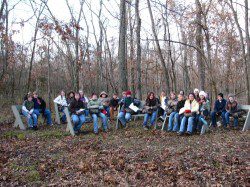 Doline Loop Trail, on the edge of a pronounced sinkhole, in the upland forest. Using a $5,000 grant from the LAD (Leo A. Drey) Foundation, volunteers organized by Dave Sturdevant, built Leopold benches for the learning station. The benches can accommodate a solitary hiker or a whole class of students. Three interpretive signs titled Forests and Watersheds, Forest Management and Forest Ecosystems accompany the benches.
Doline Loop Trail, on the edge of a pronounced sinkhole, in the upland forest. Using a $5,000 grant from the LAD (Leo A. Drey) Foundation, volunteers organized by Dave Sturdevant, built Leopold benches for the learning station. The benches can accommodate a solitary hiker or a whole class of students. Three interpretive signs titled Forests and Watersheds, Forest Management and Forest Ecosystems accompany the benches.
Fishing Piers and Boardwalk
Project completed October 2008
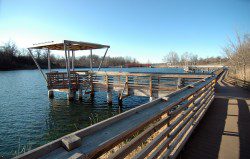 The Watershed Committee in partnership with the Missouri Department of Conservation and with a grant from the Community Foundation constructed fishing piers and a boardwalk trail on the east side of Valley Water Mill Lake. MDC is stocking and managing the fishery. These fishing piers provide recreational and educational opportunities to the public.
The Watershed Committee in partnership with the Missouri Department of Conservation and with a grant from the Community Foundation constructed fishing piers and a boardwalk trail on the east side of Valley Water Mill Lake. MDC is stocking and managing the fishery. These fishing piers provide recreational and educational opportunities to the public.
Funding was provided by the Missouri Department of Conservation: Corporate and Agency Partnership Program ($49,500), the Community Foundation of the Ozarks ($30,000) and donations by Meeks and Herman Lumber.
Watershed Management Planning Grant
Project Completed November 2009
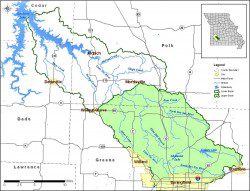 The Upper Little Sac Watershed Management Plan was initiated to address water quality issues in the watershed, help secure future 319 Grant funding, and to maintain the mission of Watershed Committee of the Ozarks; to improve and protect Springfield and Greene County water supply.
The Upper Little Sac Watershed Management Plan was initiated to address water quality issues in the watershed, help secure future 319 Grant funding, and to maintain the mission of Watershed Committee of the Ozarks; to improve and protect Springfield and Greene County water supply.
This watershed management plan is focused on the Little Sac River watershed. A watershed management plan is a living document, a vision for protecting and restoring the watershed and a plan for carrying it out. The process of watershed planning can have benefits beyond the road map that is created-it can help build a sense of community by bringing people together with different backgrounds and perspectives to define the future of their area, by helping identify the community’s cultural, historical and natural resources, and by educating the public about their watershed and the issues it faces. The Greene County Soil and Water Conservation District helped in gathering information, writing the document, contacting stakeholders, and the planning preparation for public meetings. Funding was provided through the Missouri Department of Natural Resources.
Water Savers Project with MSU & Drury
Drury Water Savers Project completed in 2009 MSU Water Savers Project completed in 2011
 Drury University, City Utilities of Springfield, and the Watershed Committee of the Ozarks have teamed up for a multi-step water conservation initiative on the Drury Campus. Through grant funding, the Watershed Committee purchased a large quantity of water conserving devices like sink aerators, low flow showerheads, leak detecting tablets and shower timers. Over the summer, in 2009, 600 showerheads and sink aerators were installed in buildings on Drury campus and 600 shower timers and leak detecting tablets were dispersed to students. Drury also sponsored the Watershed Committee to host a booth at the new student involvement fair on August 24, 2009.
Drury University, City Utilities of Springfield, and the Watershed Committee of the Ozarks have teamed up for a multi-step water conservation initiative on the Drury Campus. Through grant funding, the Watershed Committee purchased a large quantity of water conserving devices like sink aerators, low flow showerheads, leak detecting tablets and shower timers. Over the summer, in 2009, 600 showerheads and sink aerators were installed in buildings on Drury campus and 600 shower timers and leak detecting tablets were dispersed to students. Drury also sponsored the Watershed Committee to host a booth at the new student involvement fair on August 24, 2009.
In 2011, the Missouri State University (MSU), City Utilities (CU) and the Watershed Committee of the Ozarks (WCO) teamed up to encourage water conservation on the MSU campus. WCO volunteer and MSU student, Erin Murray, helped the WCO continue the Water Savers project on the MSU campus. Residence Halls on campus including Kentwood Hall, Hammons House, Hutchens House, Woods House, Blair-Shannon House, Freudenberger House and Wells House were retrofitted with sink aerators and low flow shower heads and students were given shower timers. Our estimation is the project should save over 2 million gallons of water a year.
Gargoyle Country: The Inspiring Geology of Springfield & Greene County
Project Completed 2011
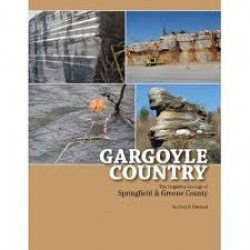 The Watershed Committee published Dr. Ken Thompson’s “Geology of Greene County” in 1986. The targeted audience was geologists and other professionals who would be conversant with geologic concepts and terminology. There were no photographs and no color illustrations, except the geologic map.
The Watershed Committee published Dr. Ken Thompson’s “Geology of Greene County” in 1986. The targeted audience was geologists and other professionals who would be conversant with geologic concepts and terminology. There were no photographs and no color illustrations, except the geologic map.
The current edition, published by the Watershed Committee in 2011 and written by Jerry D. Vineyard, targets a broader readership, using numerous illustrations to highlight the region’s interesting geology. The Geologic Map of Greene County, however, is reproduced at a smaller scale, without significant changes, because post-1986 geologic mapping has changed few details since Thompson’s ground-breaking work more than 20 years ago.
“Gargoyle Country: The Inspiring Geology of Springfield & Greene County” can be purchased at the Watershed Committee’s downtown office, Barnes and Noble or online.
Funding support provided by the Southeast Rotary Club of Springfield, Springfield Underground, City of Springfield Department of Public Works Stormwater Division, Greene County and the Watershed Committee of the Ozarks.
LAD Foundation Grant
Project Completed Summer 2011
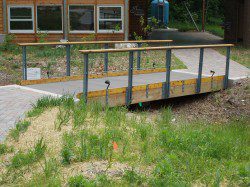 The Leo A. Drey Foundation (LAD) awarded the Watershed Committee a $5,000 grant for the entrance walkway and rain garden at the C.W. Titus Education Facility at the Watershed Center. The walkway will be constructed of recycled or sustainably grown and harvested materials, and the rain garden will provide an attractive natural amenity while slowing and filtering runoff from the building area.
The Leo A. Drey Foundation (LAD) awarded the Watershed Committee a $5,000 grant for the entrance walkway and rain garden at the C.W. Titus Education Facility at the Watershed Center. The walkway will be constructed of recycled or sustainably grown and harvested materials, and the rain garden will provide an attractive natural amenity while slowing and filtering runoff from the building area.
Springfield Plateau Chapter Master Naturalists helped plant the rain garden and Smiling Sun Landscaping donated labor and plants.
Community Innovation Grant
The Community Foundation of the Ozarks awarded Watershed Committee of the Ozarks and the Missouri State University Bull Shoals Field Station (BSFS) an $11,000 Community Innovation Grant to bring the Leopold Foundation to both the Watershed Center and BSFS to hold a Land Ethic Leaders workshop. The workshop will help participants develop their own land ethic and explore tools and methods for fostering conservation in communities locally and across the state. The workshop will be held in November of 2016.
Solid Waste District O Grant
Project Completed July 2011
 The Watershed Committee of the Ozarks was awarded a Solid Waste District O grant in the amount of $50,000 to demonstrate the use of recycled products in the meeting room at the C.W. Titus Education Facility at the Watershed Center. This will include recycled aluminum windows, recycled plastic in carpeting, low VOC paints and adhesives, cabinetry made of reused wood and energy efficient lighting.
The Watershed Committee of the Ozarks was awarded a Solid Waste District O grant in the amount of $50,000 to demonstrate the use of recycled products in the meeting room at the C.W. Titus Education Facility at the Watershed Center. This will include recycled aluminum windows, recycled plastic in carpeting, low VOC paints and adhesives, cabinetry made of reused wood and energy efficient lighting.
Little Sac Restoration and Improvement Project
Project Summary:
Watershed Committee of the Ozarks was awarded a subgrant agreement from the Missouri Department of Natural Resources to improve the drinking watershed of Springfield and Greene County. The project will focus on reducing the loading of pollutants identified in the 303(d) watershed(s) and accompanying Total Maximum Daily Load (TMDL) for the Upper Little Sac River, as described and recommended in the watershed based plan for that basin, by targeting the sub-watershed for the implementation of BMPs that will reduce nonpoint source pollution. The approach of this project will be to monitor the performance of the selected best management practices (BMPs). Practices will include a demonstration of Longitudinal Peaked Stone Toe Protection (a method of stabilizing eroding banks), prescribed grazing systems, bank vegetative buffers, and alternative livestock watering sources at individual sites and regional levels in the sub-watershed, as well as estimate sub-watershed pollutant loading improvements at sub-watershed outlets. The BMP designs and improvements will then be incorporated into criteria manuals for future policies and ordinances addressing agricultural and urban water quality. Project partners, namely City Utilities of Springfield, the Greene County Soil and Water Conservation District, and the Missouri Department of Conservation will assist in BMP implementation and monitoring of the projects implemented.
On June 21, 2018 the Missouri Department of Natural Resources awarded an additional grant amendment bringing the total grant funding to $380,442 with a required $225,222 in local match. The final year of the grant will be focused on writing and updating our EPA nine element Upper Little Sac Watershed Management Plan. The grant will be extended until May 31, 2019.
As part of the Little Sac Restoration and Improvement Project on November 6-8, 2017 the Watershed Committee of the Ozarks hosted a hands-on educational workshop, which coincided with the construction of a stream stabilization project on the Little Sac River. Forty people participated in the workshop to help construct the Longitudinal Peaked Stone Toe Protection streambank stabilization project, which includes an engineered floodplain bench, bendway weirs, unrooted live pole plantings, vegetated and curved keys, and rooted stock plants. Mr. Dave Derrick a Potomologist and Stream Stabilization Specialist with River Research & Design, Inc. from Vicksburg, MS with over 20 years’ experience lead the workshop and provided construction oversight.
This project helps reduce nonpoint source pollutants from entering the Little Sac River, which will benefit our drinking water supply for many years to come. We are very thankful to all of our community partners that made this project possible including the landowners, the grant steering committee, Missouri Department of Natural Resources, Greene County, Missouri Department of Conservation, Wildscape Environmental Services and all of our workshop attendees!
The final year of the grant will be focused on writing and updating our EPA nine element Upper Little Sac Watershed Management Plan. Part of the plan updates include the Bacteria Source Tracking Report for the Little Sac River, which was recently completed by Missouri State University Ozarks Environmental and Water Resources Institute. Bacteria samples were collected at five sites in the watershed in fall 2017 to look for presence of human, bovine, chicken, goose and dog bacteria markers. The results can be found below:
MO Bird Conservation Initiative Grant
- The Watershed Center is a birding hot-spot because of the habitat diversity, access to water, and proximity to City—it’s important for the birds, and for teaching people about conservation.
- Ebird data shows 189 bird species have been reported at Valley Water Mill Park which illustrates the importance of this location to migrating and nesting birds, and to the dedicated people who watch and study them at the Watershed Center.
- Of the 189 bird species recorded here, three species, the Northern Harrier, Snowy Egret, and Peregrine Falcon are designated Endangered in the State (Missouri Species and Communities of Conservation Concern Checklist, Missouri Department of Conservation, 2016).
- The location will be on the Great Missouri Birding Trail in 2017.
- The Greater Ozarks Audubon Society (GOAS) has a long-term commitment and involvement to the site, with projects including feeder stations, a waterfowl observation blind, a watering bubbler and chimney swift towers. GOAS frequently leads field trips to the site.
- In 2015, over 3,500 students visited the Watershed Center and participated in educational programs; the surrounding Valley Water Mill Park is visited by thousands of people each year.
- Our wetland and small reservoir are spring-fed and stay ice free most winters, making it an important resting place for migratory waterfowl during extended cold periods.
- We work to explain these and other methods of implementing good land stewardship to program participants, visitors, and volunteers, hopefully multiplying the impact.
- Habitat improvements to our grassland parcels will provide benefits for birds and native pollinators such as monarchs, and increase ecosystem diversity.
- We work closely with MDC, Missouri Master Naturalists, Greater Ozarks Audubon Society, Springfield Greene County Park Board, the City of Springfield, and Greene County which provides excellent partnerships for education and data gathering, such as “bio-blitz” activities.
- This project will involve a massive amount of volunteer participation and labor providing significant in-kind resources.
Sac and James River Watershed Conservation Outreach Project
The Watershed Committee of the Ozarks was awarded the USDA Conservation Technical Assistance Grant for $49,0000 on September 15, 2018. The project is to promote public awareness and implementation of Farm Bill activities, especially in historically underserved communities and in watersheds critical to drinking water supply.
As part of the grant WCO has created a survey to understand the knowledge farmers, producers and growers have of the farm bill practices and cost share programs currently available. A local contact list for the watershed is being generated to disperse the survey. As part of the grant milestones outreach conservation workshops will be conducted focusing on soil health and managed grazing.
Dear Future Community Challenge Grant by Coca-Cola Company
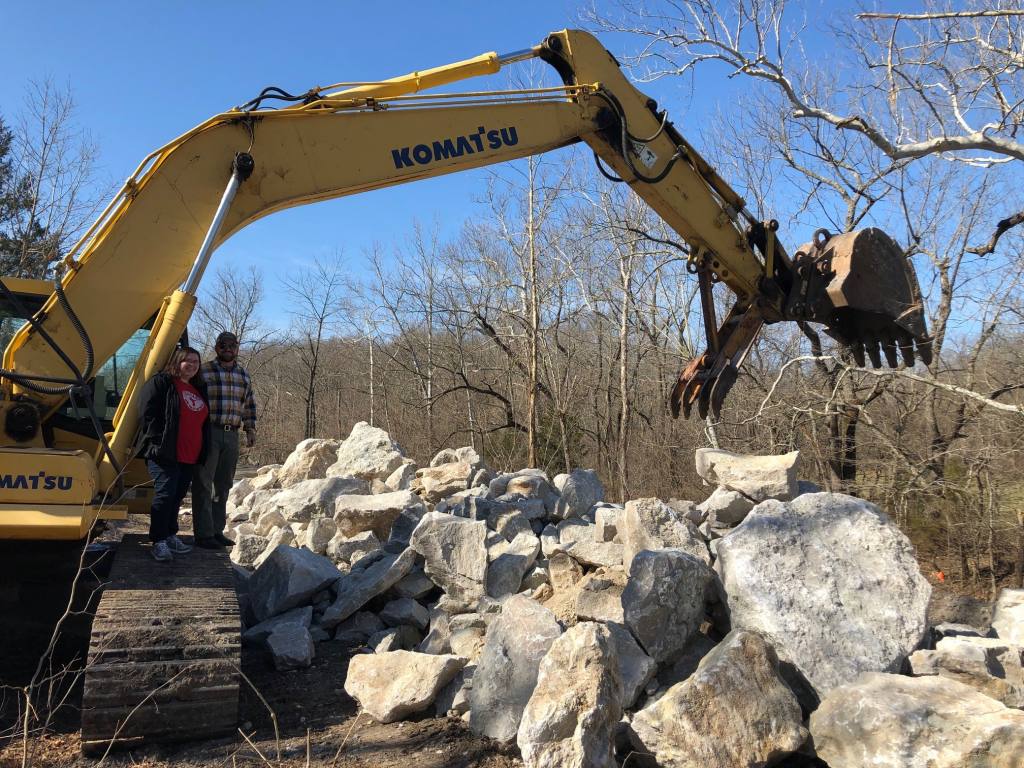
The Coca-Cola Company and its family of 68 independently owned bottlers across the country invited young Americans to help deliver a better tomorrow through the “Dear Future [Community] Challenge.” Locally, Ozarks Coca Cola Dr. Pepper Bottling Company and Watershed Committee of the Ozarks teamed up to ask students and young adults at Drury, MSU, and OTC their ideas “to protect and restore Ozarks water resources.” After reviewing many submissions, an award of $30,000 went to Ashley Cusic for her idea to protect and restore waters by preventing erosion and planting native plants. WCO served as a mentor and fiscal agent to help Ashely actualize her idea.
WCO surveyed local partners for “needs” or projects that might align with Ashley’s idea. Ashley decided the best fit was a project need of Ozark Greenways. A section of the Frisco Highline trail, located within Springfield’s water supply area, was eroding badly. With the investment from Coke and Ashley, Ozark Greenways was able to fund the work to stabilize the stream bank with stone and native plants. This unique project provided the opportunity to engage many students, build a relationship with Ozarks Coca Cola Dr. Pepper Bottling Company, and our student partner Ashley, as well as fix a problem and make he water cleaner.
Partners
Ozarks Coca-Cola/Dr. Pepper Bottling Co., Ozark Greenways, Wildscape Environmental
C.W. Titus Grant
Project Summary
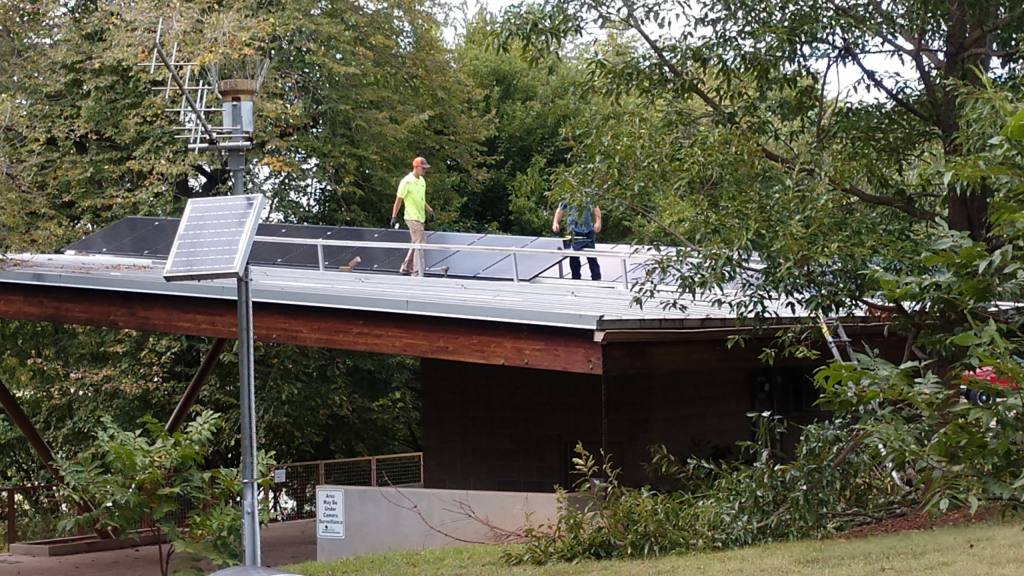
Late in 2018, the C.W. Titus foundation came through with a grant which should allow the Watershed Center to become net-positive, or to generate more energy than we consume. The way we hope to get there is two-fold. The grant will allow us to do a major energy efficiency upgrade to the outdoor restrooms attached to the C.W. Titus Education Facility. The restrooms use a prodigious amount of energy because of the uninsulated structure with electric resistance heating (think giant space heaters in a two story continually vented chimney). In 2019, in partnership with Springfield Greene County Parks, we will add insulation, lower the ceilings, and add a highly efficient heat source called a mini-split heat pump system. The area above the new ceilings will also add an attic storage space which will be useful as we grow. The remainder of $45,000 grant will allow us to add roof-mounted solar panels to the Lakeside Pavilion, which is an excellent location for solar based on the access to direct sun and a separate meter which can be utilized. The generosity of the HDR employees through the HDR foundation, the C.W. Titus Foundation, Sunbelt Environmental, and the Springfield Greene County Park Board have lead to some incredible developments, and we are excited to report on the outcomes in our 2019 annual report.

